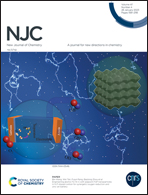Intrinsic influence of selenium substitution in thiophene and benzo-2,1,3-thiadiazole on the electronic structure, excited states and photovoltaic performances evaluated using theoretical calculations†
Abstract
In organic solar cells (OSCs), non-fullerene acceptors (NFAs) are of great significance compared with the traditional fullerene-based acceptor molecules. Based on the milestone NFA Y6, five new A–D–A′–D–A type NFAs by substituting the S atoms of A′ and D units with Se atoms were designed and systematically simulated from the viewpoint of Quantum Chemical Calculations. The physical and optical properties of the newly designed Y6 series are predicted with reliable density functional theory (DFT) and time-dependent density functional theory (TD-DFT) calculations. The frontier molecular orbitals (FMOs), the density of states (DOS), electrostatic potentials (ESP), electron mobility, and intramolecular charge transfer (ICT) of these Y6 derivatives are computed to comprehensively analyze their potential for OSCs performances. Besides, the polymer donor PM6 and the studied acceptors were specifically investigated. The results show that the Se-substituted molecules possess a lower band gap, exciton binding energy, reorganization energy values, and more red-shifted absorption than Y6. The molecule B4(Y-Se-Se-Se) has the most obvious redshift. In addition, the results of the hole–electron analysis showed that B3(Y-Se-S-Se) has a larger D index and a smaller Sr index, which will facilitate exciton separation and charge transfer. Furthermore, the lowest values of Ecoul and λe of A4 (Y-S-Se-Se) offer high current charge density along with good electron transport ability. This suggests that the determinant of excellent molecular performance is not a large number of Se substitutions. These results provide a theoretical basis for further understanding the effect of Se atom substitution on photovoltaic performance improvement and also provide a theoretical basis for the design and screening of novel acceptors.



 Please wait while we load your content...
Please wait while we load your content...